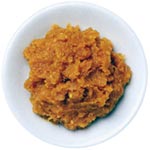|
Miso can be divided into these categories: rice miso, barley miso, soybean miso, and other types. Ishikawa miso combines gkojih (cultured rice grain), soybeans, and salt, which produce a rice miso. Rice miso is widely produced nationally, and has several types such as sweet, spicy, red, gold, and so forth based on color or taste. 80 percent of miso produced in Japan is rice miso.
Kaga-Noto Miso was produced in temples in Kaga and Noto, including Kanazawafs Oyama Gobo temple, and once Lord Toshie Maeda occupied the Kanazawa Castle, production increased to create stockpiles for war. In those days it was common all over the country for miso to be made in the home, so Kanazawa became know as the gMiso Warehouseh, and about halfway through the Maeda clanfs rule, miso was being sold in stores. As selling became organized, it goes without saying that the pursuit of taste followed as well.
 An enjoyable aspect of Kaga-Noto Miso is that its rich flavor allows miso
soup to be slightly thinned. Additionally, if sliced fish or clams are
chosen for ingredients for miso soup, the flavors are enhanced. It is also
very suitable in the case of more subtle ingredients like Japanese vegetables
(daikon, gobo, sato imo) or any vegetable having gumamih, as well deep
fried bean curd (abura-age). It also matches well in a mix with white miso
or Hatcho miso. An enjoyable aspect of Kaga-Noto Miso is that its rich flavor allows miso
soup to be slightly thinned. Additionally, if sliced fish or clams are
chosen for ingredients for miso soup, the flavors are enhanced. It is also
very suitable in the case of more subtle ingredients like Japanese vegetables
(daikon, gobo, sato imo) or any vegetable having gumamih, as well deep
fried bean curd (abura-age). It also matches well in a mix with white miso
or Hatcho miso.
Noto Miso
The characteristics include having high moisture content, being soft, and salty. As it is very moist, it is easy to work with, and in the past the excess liquid (tamari) was originally used as substitute for soy sauce in some regions. Additionally, as preparation for bad harvests, it was customary to stockpile a three years supply of miso, and for that reason a high salt content was required. Currently tamari is not used as a soy sauce substitute, but if it is home made or factory produced, the Noto Miso qualities are protected, and for dishes using seafood, its moisture and saltiness make it the most suitable miso available. |
|
Kaga Miso
Kaga Miso is carefully made over a long period until it is mature, and
from its particular abundance of gkojih, even for a Hokuriku miso, it
takes on richness from the sugar content of the rice. It has a sunlight
yellow color, and a subtle spiciness. It definitely can be called a gcountry
styleh miso, for when it is used in miso soup, some remains of the pulverized
soybeans can be found at the bottom of the soup cup.
|
Presently, the miso that is primarily produced in Kanazawa has the same high moisture content and softness, the color is lighter, and in miso soup the gkojih drifts to the surface, but there are practically no beans that remain. Generally speaking, the increase of gkojih over the years has provided an increase in gumamih for robust miso.
|

![]()
 An enjoyable aspect of Kaga-Noto Miso is that its rich flavor allows miso
soup to be slightly thinned. Additionally, if sliced fish or clams are
chosen for ingredients for miso soup, the flavors are enhanced. It is also
very suitable in the case of more subtle ingredients like Japanese vegetables
(daikon, gobo, sato imo) or any vegetable having gumamih, as well deep
fried bean curd (abura-age). It also matches well in a mix with white miso
or Hatcho miso.
An enjoyable aspect of Kaga-Noto Miso is that its rich flavor allows miso
soup to be slightly thinned. Additionally, if sliced fish or clams are
chosen for ingredients for miso soup, the flavors are enhanced. It is also
very suitable in the case of more subtle ingredients like Japanese vegetables
(daikon, gobo, sato imo) or any vegetable having gumamih, as well deep
fried bean curd (abura-age). It also matches well in a mix with white miso
or Hatcho miso.